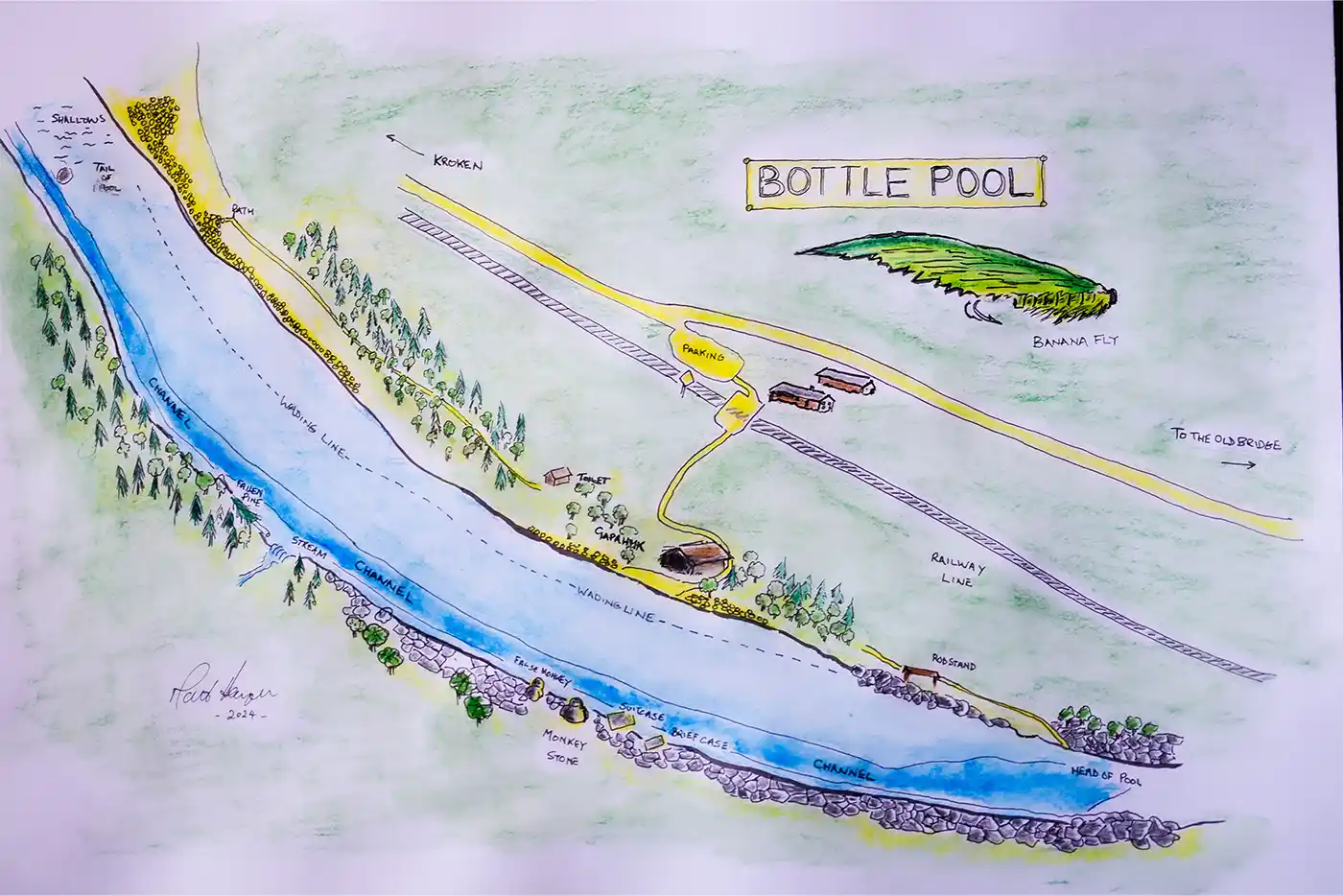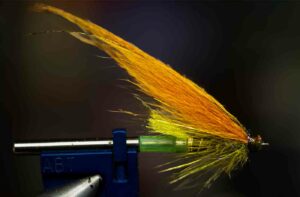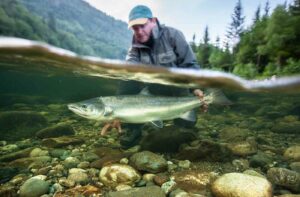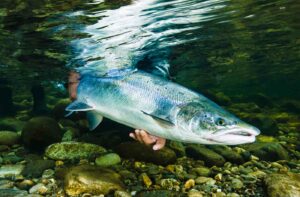The Bottle Pool
The Bottle pool is a classic fly pool. Over 500m long and with a chance of a fish from the top to the tail, it contains several hotspots. If it has a drawback, it is that it is on the ‘wrong’ side of the river, necessitating casting left hand up the rod or double spey, snake roll etc.,
The bottle pool got its name, apparently, when a British angler fishing the pool in the late nineteenth century, threw a whiskey bottle into the pool. Whether it was full or not, we have no idea.
In truth, whilst the history of the bottle pool is folklore, what is more alluring and mysterious is the debate surrounding the legendary monkey stone which some believe dominates the pool.
Devotees of the monkey pay homage to it and insist that singing the Monkey Stone a song it likes is the key to success.
The Legend of the Monkey Stone
There are those that believe the key to catching fish from the pool is sound fly choice and good casting. This is true but devotees will tell you that the real key to unlocking the bottle Pool is to see the monkey. This stone ape, located exactly in line with the left hand upright of the fishing hut, is not so much a stone as several stones that do indeed resemble an orangutan!
Certain anglers ‘see the monkey‘ more regularly than others and it is thought that those who e enjoy a good drink are more likely to see it.
There are those too, myself being one of them that insists on singing a song for the monkey on the first run down the pool. ‘Daydream Believer‘ is a favourite but ‘King of the Swingers‘ seems to do it every time.
We know from experience that one fly above all others reigns supreme on the Bottle Pool and you won’t be surprised to learn that it is the banana fly. What else could it be?
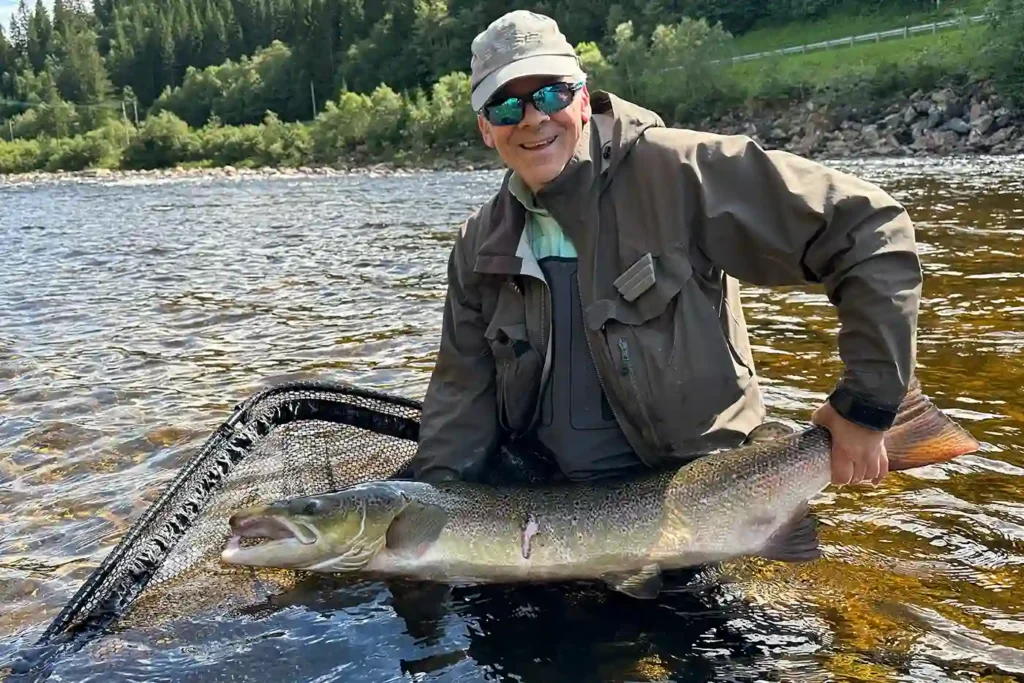
Andrew Beattie’s 30 pounder came from the head of the pool after a good rise in water. The head is often the place to find a big fish, especially when the water is up.
Tactics for the Bottle Pool
The bottle pool is relatively straightforward to fish due to its uniform flow from bank to bank, with the fastest water on the far side – exactly how you want it.
As you can see the salmon are staged along the length of the bottle pool and there are a number of taking spots, the hottest area being outside the hut.
Tactics
Since anglers fish in pairs, it’s good to have a strategy. When I fish with Andy Eriksen or Glenn Hole, one of us will take the top, the other the bottom. Sometimes we make shorter runs, fishing just the area from the head to the Gapahuk but this but this puts the water under quite a lot of pressure and it is necessary to give the water good rest on a regular basis.
The angler at the top will go in above the rod stand, and right at the head of the pool tucked in. Fishing is from the rocks, off the shore, until you reach the area indicated by the dotted line. The wading starts where the row of trees downstream of the rod stand begins.
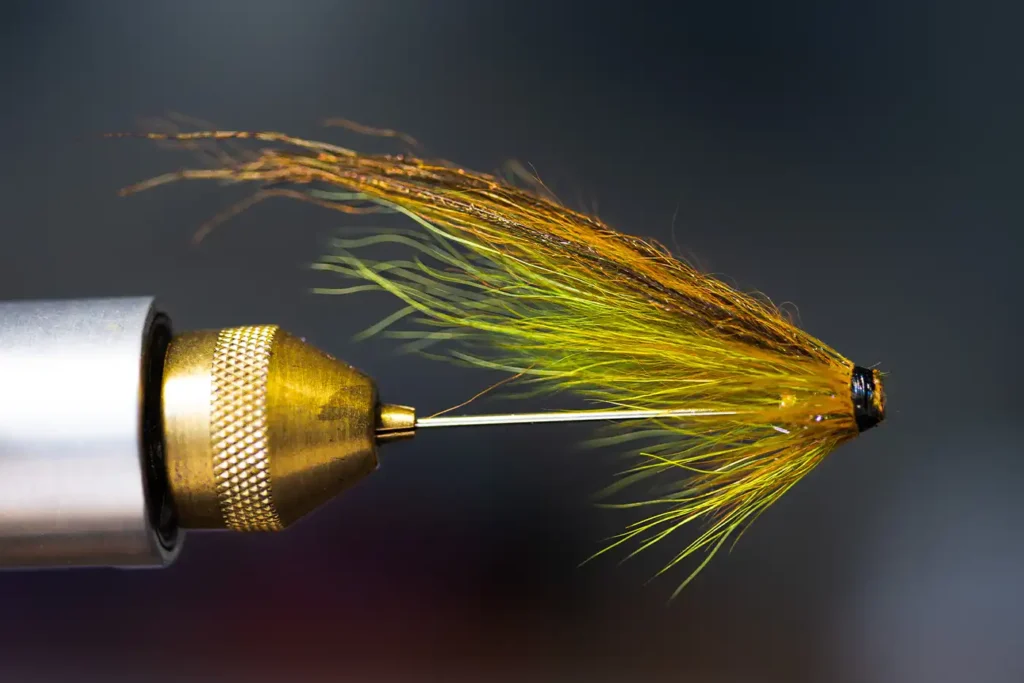
The banana fly is effective all over the fishery but nowhere more so than the bottle pool. This fly accounts for a good percentage of the catches on the pool in a typical season.
The second angler should set off at lest 100 meters below the angler at the top, approx. half-way between the head of the pool and the hut.
Better still, is to start one angler at the top and the other starting outside the hut. This tactic is only possible in lower water levels since wading can be tricky in higher water. However, when it is fishable, the lower end of the pool can be very good, especially when the fish are running. The fish come into the pool via a narrow, deeper channel on the far side of the shallow rapids.
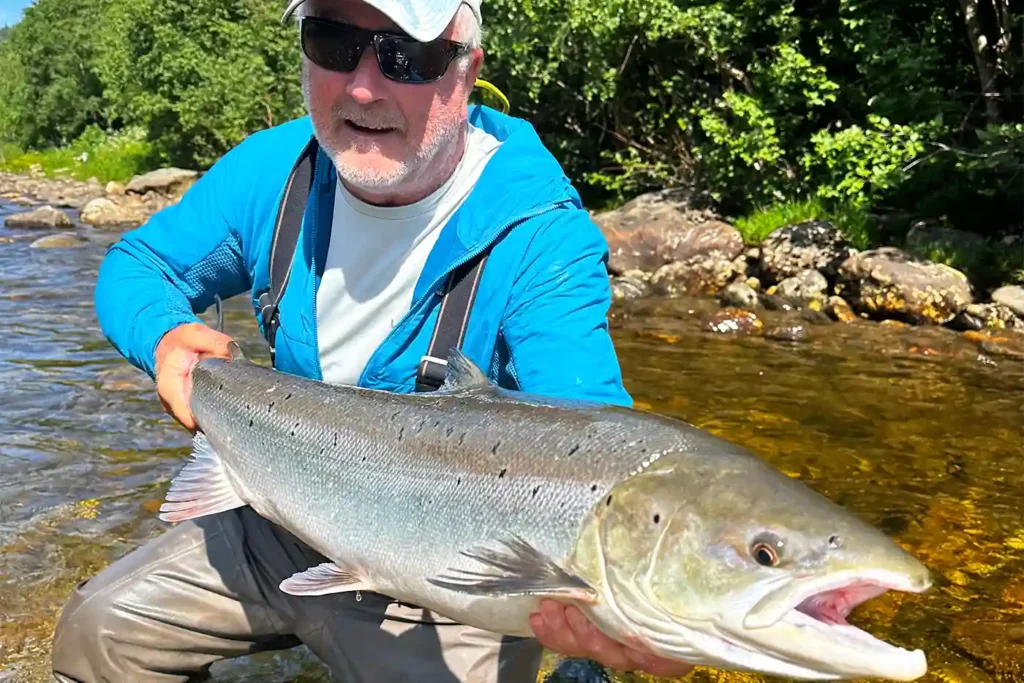
Hasse with a fine fish from the lower part of the head of the pool, where the wading begins. This area throws up fish in higher water in the area that you wade. The depth shelves up here and the structure is attractive to salmon when the water is up.
The first few casts at the top of the pool are always made with some anticipation. The fish are tucked over toward a small bay on the far side and this is a position that they favour at medium and low water. In high water, fish can be found closer to the casting bank and the area where your fly is swinging in line with where the trees on the bank start on your right is a good spot for a big fish. Casting left hand up off the bank is not everyone’s cup of tea but if you can get some decent casts out here, you have a very good chance.
Working your way along the right bank, you will see that the trees start to form a continuous line down to the hut. You can enter the water just below where the trees start and wade a comfortable distance from the bank. In high water, you will need to stay close to the shore but there is a shallow reef running from the trees almost to the hut in the centre of the river and fish are often found staging alongside. In normal water conditions, you should wade between 25% and 30% out and maintain that line all the way to the hut. There is an excellent chance of fish along the run, in the channel, between the head and the hut. Running salmon and residents can be caught here.
As you approach the hut, you will enter a sweet spot. The flow picks up slightly here and fishes the fly a bit faster, something that the fish like. Indeed in all but high water conditions, I like to cast quite square in the upper part of the pool to maximise fly speed.
On the far bank there are two hotspots that are marked as ‘suitcase‘ and ‘brief case.’ Fish regularly show in the area around these stones and they were named by the late Kurt Maurer.
Kurt’s finest creation is ‘The Monkey Stone‘ which is directly in line with the left hand upright of the fishing hut when you are sitting in it, looking across the river. It is hard to see the monkey which is not one stone but a collection that when viewed with a creative mindset look like an orangutan. If there are fish in the pool, there will be a fish on the monkey stone but that does not mean that you will catch it!
Just below monkey is ‘false monkey‘ which is an imposter that occasionally attracts fish. You will see just below the hut on the far bank some ripples in the water formed by some submerged stones. The far side of these stones in normal/low water or inside the stones in high water, is a hotspot.
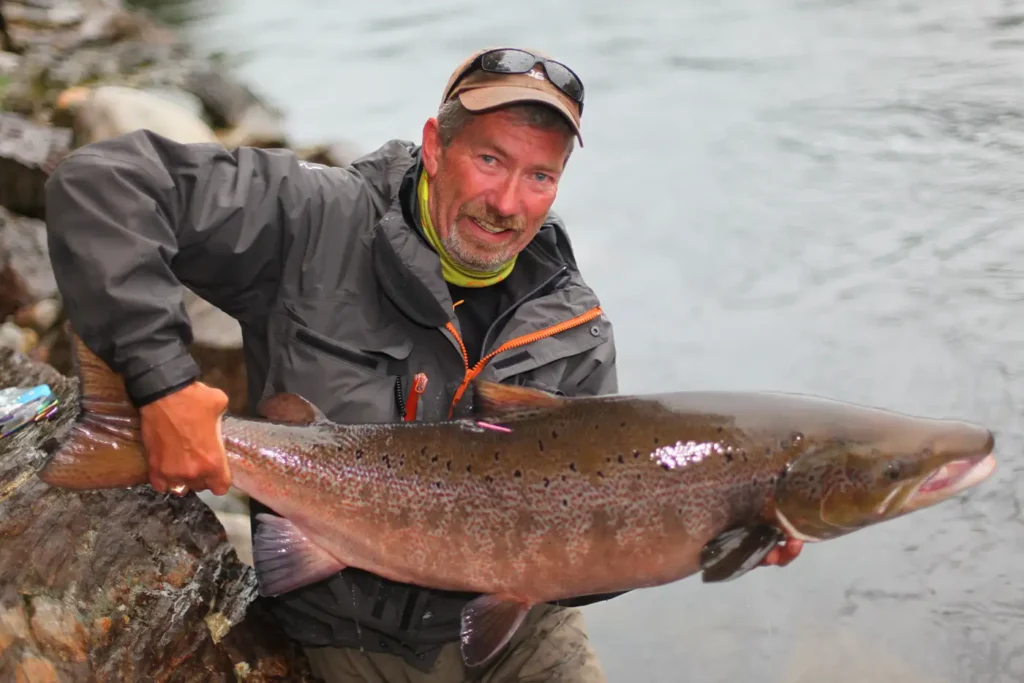
Stein Thorvaldsen with a huge male fish caught during a semi-flood with a fish from the far side of the pool. Its a decent tactic when the water is up but appears to spook the fish when the water is lower.
Below the gapahuk, the riverbed is more uneven. Just below the hut, stay close to the bank to avoid walking into a depression on the river bed. Keep casting but stay quite close in until you hear the tinkling sound of a stream on the far bank. Look across the river for a pine tree that has fallen on its side at the water’s edge. In this area you can begin to wade further out and try to reach the channel on the far side. This is tricky for all but anglers strong at wading and experienced casters. The water in the channel is shallower here and disturbance will kill your chances. You need to cast long and quietly from now on.
You will get two or three chances to cover fish between the fallen pine and the tail where you probably have the best chance of all.
As you approach the shallows, don’t wade too deep and make some casts so that the fly swings the middle area as it forms the rapids. After this, make longer casts and wade a little further out so that you cover the area in front of the small slot right over on the far side on the shallows.
Who fishing their bottle pool, I would recommend lines between floating and I/2/4 for the top half of the pool. For the bottom half, use lines that sink no deeper than sink1/2 and do not use heavily weighted flies.
